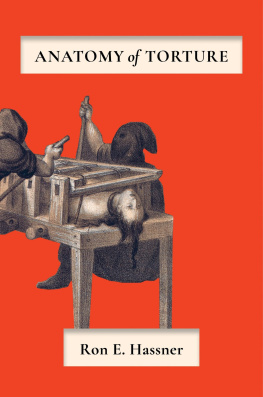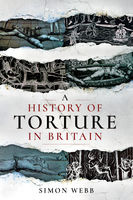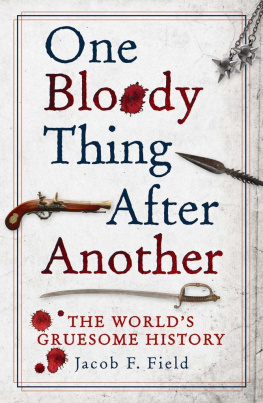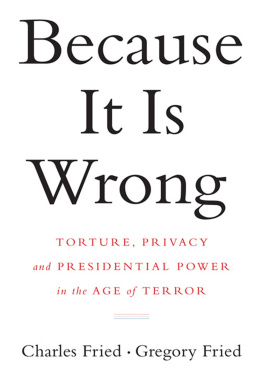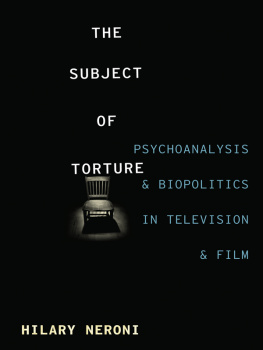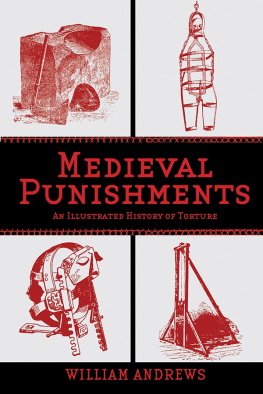Torture and Brutality
in Medieval Literature
Negotiations of National Identity
An ugly subject, but one that needs to be treated thoroughly and comprehensively, with a discreet wit and no excessive relish. These needs are richly satisfied in Larissa Tracys bold and important book. DEREK PEARSALL, Professor Emeritus, Harvard University.
Torture - that most notorious aspect of medieval culture and society - has evolved into a dominant mythology, suggesting that the Middle Ages was a period during which sadistic torment was inflicted on citizens with impunity and without provocation: popular museums displaying such gruesome implements as the rack, the strappado, the gridiron, the wheel, and the Iron Maiden can be found in many modern European cities. These lurid images of medieval torture have re-emerged within recent discussions on American foreign policy and the introduction of torture legislation as a weapon in the War on Terror, and raised questions about its history and reality, particularly given its proliferation in some literary genres and its relative absence in others.
This book challenges preconceived ideas about the prevalence of torture and judicial brutality in medieval society by arguing that their portrayal in literature is not mimetic. Instead, it argues that the depictions of torture and brutality represent satire, critique and dissent; they have didactic and political functions in opposing the status quo. Torture and brutality are intertextual literary motifs that negotiate cultural anxieties of national identity; by situating these practices outside their own boundaries in the realm of the barbarian Other, medieval and early-modern authors define themselves and their nations in opposition to them. Works examined range from Chaucer to the Scandinavian sagas to Shakespeare, enabling a true comparative approach to be taken.
Contents
Acknowledgements
This project has had an extended evolution, and there are many people to whom I owe a debt of gratitude for their input, insight, assistance, and guidance. I would like to thank my current colleagues at Longwood University for their support and suggestions, and my former colleagues at American University, Georgetown University, George Mason University, and the University of Mary Washington (then Mary Washington College) for their suggestions and advice over the years.
In particular I extend my warmest gratitude and thanks to the following people who have helped me along the way and contributed in various ways to my research and education: Terry Barry, Betty Bennett, Julia Boffey, Rachael Bork, Niall Brady, John Bradley, Rhonda Brock-Servais, Jesse Byock, Christa Canitz, Melissa Castle, Mark Chambers, Margaret Connolly, Helen Cooney, Eugene Crook, Raymond Cormier, Angela Dadak, Carol Dover, Ian Doyle, Martha Driver, Warren Edminster, A.S.G. Edwards, Samantha Elliot, Melissa Elmes, Susanna Fein, Rachel Frier, Angie Gleason, Richard Hamer, Thomas D. Hanks, Aisling Hayden, J. Patrick Hornbeck, Steven Isaac, Renata Lana, Charles Larson, Katherine Lewis, Nicolas Lizop, Susan May, Rick McDonald, Sarah McNamer, Jeffrey Middents, Jo Ann Moran Cruz, Gerald Morgan, Samantha Mullaney, Eillen N Cuilleanin, Marianne Noble, Dan OSullivan, Edward Peters, J.D. Pheifer, Amanda Piesse, Sherry Reames, Roberta Rubenstein, Vida Russell, Catherine Sanock, Matthew Solomon, A.P. Smyth, Kristen Stazioski, Myra Sklarew, Penn Szittya, Kelley Wickham-Crowley, and Jocelyn Wogan-Browne.
Chapter Five is the product of a National Endowment for the Humanities Research seminar on Old French fabliaux directed by R. Howard Bloch at Yale University. I am grateful for his encouragement and the continued community of my fellow NEH seminarians: Peter G. Beidler, Sam Bloom, Holly Crocker, Ellen Friedrich, Susanne Hafner, Jean Jost, Mary Leech, Dan Murtaugh, Sheila Nayar, Kiril Petrov, Dorothy Schrader, Christian Sheridan, Nicole Sidhu and Judith Tshann. was inspired by a National Endowment for the Humanities Teaching Institute at the University of Maryland, hosted by the Center for Renaissance and Baroque Studies, directed by Adell Seef. I am grateful to my colleagues at that institute for their ideas, suggestions and input, specifically Thomas Herron and Susannah Brietz Monta.
For editing earlier versions of this manuscript, I wish to thank Jeff Massey. I am indebted to Alice Kirby for collating the references and for cross-checking my notes. I am extremely grateful to Derek Pearsall for reading the entire manuscript and offering his generous and encouraging criticism and to Martha Cook for copy-editing the final version.
I would like to thank Caroline Palmer for her continued direction and guidance, and for helping me make sense of it all. I owe an enormous debt of gratitude to David F. Johnson and John Scattergood. I would also like to thank my parents, Robert Tracy and Nina Zerkich, for their continued support. Rikk Mulligan has been my steadfast companion, proofreader, and sounding board from the inception of this project, and I could not have done it without him.
Finally, I would like to thank the manuscript departments at Trinity College, Dublin; the British Library, London; the Bodleian Library, Oxford; the Beinecke Library at Yale University; the Folger Library, Washington D.C.; and the Bibliothque Nationale Franaise, Paris for their assistance in compiling this volume and granting me access to select manuscripts. I am indebted to Toshi Takamiya for his generous permission to study the fifteenth-century prayer roll that is part of his private collection, and for his insights on this text.
Sections of also includes some material from my book Women of the Gilte Legende: A Selection of Middle English Saints Lives (London: D.S. Brewer, 2003). I am grateful to the readers and editors of Boydell and Brewer, Florilegium and JEBS for their insightful and excellent comments, their suggestions regarding these articles in their first form, and for permission to reproduce revised versions here.
Abbreviations
Actes and Monuments | John Foxe, Actes and Monuments of these Latter and Perillous Days, Touching Matters of the Church . Ed. Rev. M. Hobart Seymour. New York: Worthington Co., 1850. |
Agatha | The Life of Saint Agatha in Gilte Legende . Ed. Richard Hamer with the assistance of Vida Russell. Vol. 1, EETS, os 327. Oxford: Oxford University Press, 2006: 1759; and The South English Legendary, Corpus Christi College Cambridge MS 145 and British Museum MS Harley 2277 . Ed. Charlotte DEvelyn and Anna J. Mill. Vol. 1, EETS, os 235. Oxford: Oxford University Press, 1956, reprinted 1967: 549. |
Christina | The Life of Saint Christina in Gilte Legende . Ed. Richard Hamer with the assistance of Vida Russell. Vol. 1, EETS, os 327. Oxford: Oxford University Press, 2006: 4836; and The South English Legendary, Corpus Christi College Cambridge MS 145 and British Museum MS Harley 2277 . Ed. Charlotte DEvelyn and Anna J. Mill. Vol. 1, EETS, os 235. Oxford: Oxford University Press, 1956, rpt. 1967: 31527. |
De Connebert | De Connebert ( Liprestrekiperdilescolles ), in Nouveau Recueil Complet des Fabliaux . Ed. Willem Noomen and Nico van den Boogaard. 10 vols. Assen: Van Gorcum, 19831998. Vol. 7, 1993. |
EETS, os | Early English Text Society, Original Series |
GiL | Gilte Legende . Ed. Richard Hamer with the assistance of Vida Russell. 2 vols, EETS, os 327, 328. Oxford: Oxford University Press, 20067. |
Havelok |
Next page


